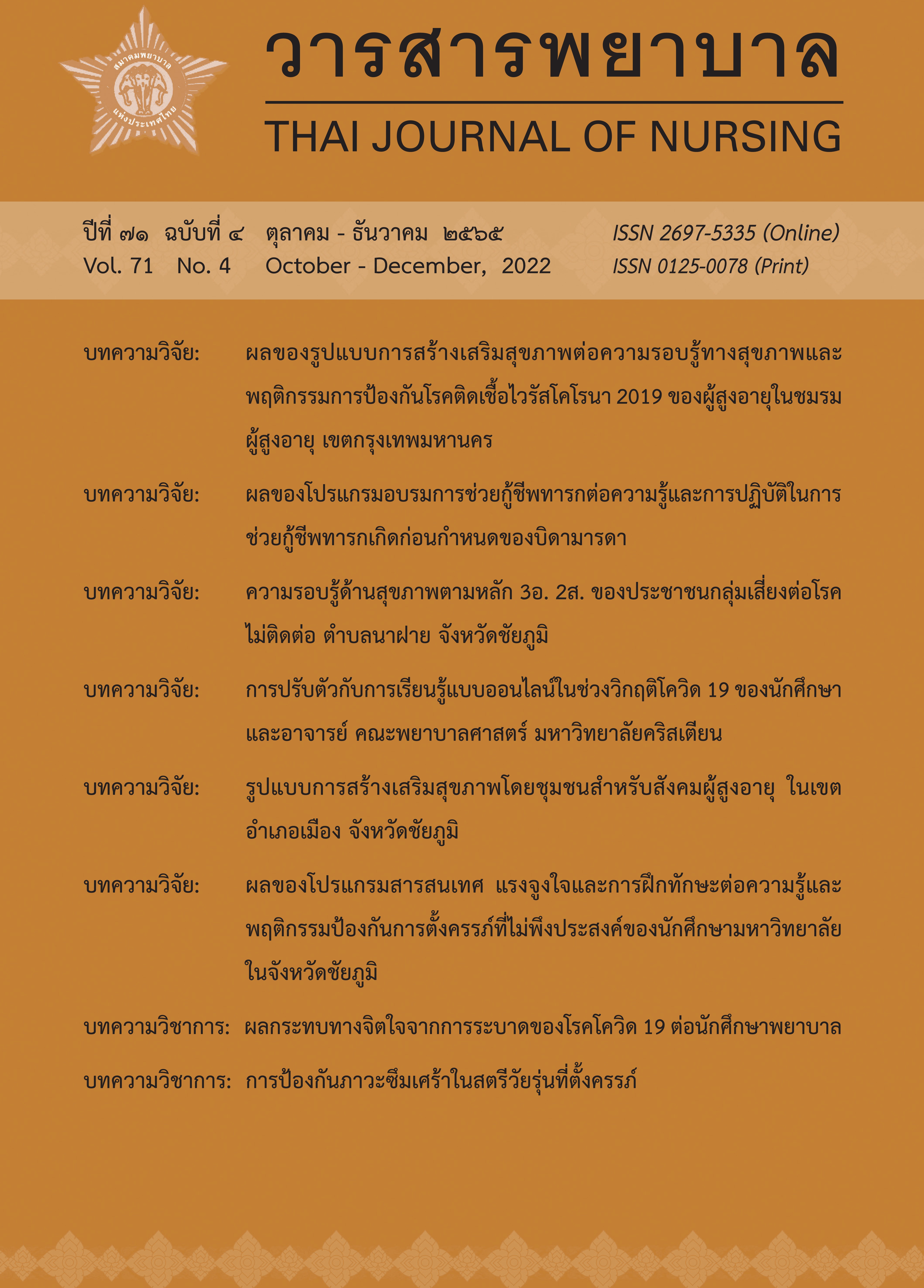Effects of infant-resuscitation training program on knowledge and practice of infant resuscitation among parents of premature infants
Main Article Content
Abstract
The purpose of this quasi-experimental study was to compare the knowledge and practice of infant resuscitation between premature infants’ parents or caregivers who received infant-resuscitation training program and those who received routine training of the ward. Participants were parents or caregivers of premature infants who were admitted to a neonatal ward of the university hospital. Fifty-two of them were selected based on the inclusion criteria and divided into experimental and control groups (26 in each group). The experimental group received the infant-resuscitation training program while the control group received the routine training of the ward. Data were collected from parents or caregivers’ demographic data questionnaire, infants’ demographic data questionnaire, infant-resuscitation knowledge test, and the observational record form of infant-resuscitation practice. Descriptive statistics, ANCOVA, and Chi-square test were used for data analysis. The study results revealed that after receiving the intervention, the experimental group had higher mean scores of infant-resuscitation knowledge than the control group with statistical significance (F = 34.65, p < .001) and the experimental group had very good scores of infant resuscitation practice with higher proportion than the control group with statistical significance (2 = 11.31, df =2, p = .003).
Article Details

This work is licensed under a Creative Commons Attribution-NonCommercial-NoDerivatives 4.0 International License.
References
ทิศนา แขมมณี. (2558). ศาสตร์การสอน: องค์ความรู้เพื่อการจัดกระบวนกาเรียนรู้ที่มีประสิทธิภาพ (พิมพ์ ครั้งที่ 19). กรุงเทพมหานคร: จุฬาลงกรณ์มหาวิทยาลัย.
โรงพยาบาลศิริราช. (2565). รายงานสถิติประจำปี หอผู้ป่วยอรรถกระวีสุนทร โรงพยาบาลศิริราช ปีงบประมาณ 2560-2564. กรุงเทพมหานคร: ผู้แต่ง.
ลดาวรรณ อุบล. (2559). การสอนช่วยชีวิตขั้นพื้นฐานด้วยวีดิทัศน์สำหรับผู้ดูแลผู้ป่วยเด็กที่เสี่ยงต่อการเกิดภาวะหัวใจหยุดเต้น. วารสารพยาบาลศาสตร์, 34(3), 66-78.
Barr, G. C., Rupp, V. A., Hamilton, K. M., Worrilow, C. C., Reed, J. F., Friel, K. S., . . .Greenberg, M. R. (2013). Training mothers in infant cardiopulmonary resuscitation with an instructional DVD and manikin. The Journal of the American Osteopathic Association, 113(7), 538-545. doi:10.7556/jaoa. 2013.005
Chu, P. Y., Li, J. S., Kosinski, A. S., Hornik, C. P., & Hill, K. D. (2017). Congenital heart disease in premature infants 25-32 weeks' gestational age. The Journal of Pediatrics, 181, 37-41.e1. doi:10.1016/j.jpeds.2016.10.033
Davidson, L. M., & Berkelhamer, S. K. (2017). Bronchopulmonary dysplasia: Chronic lung disease of infancy and long-term pulmonary outcomes. Journal of Clinical Medicine, 6(1), 4.
Fink, E. L., Prince, D. K., Kaltman, J. R., Atkins, D. L., Austin, M., Warden, C., . . . Callaway, C. W. (2016). Unchanged pediatric out-of-hospital cardiac arrest incidence and survival rates with regional variation in North America. Resuscitation, 107, 121-128. doi:10.1016/j.resuscitation.2016.07.244
Goldberg, N., Rodriguez-Prado, Y., Tillery, R., & Chua, C. (2018). Sudden infant death syndrome: A review. Pediatrics Annals, 47(3), e118-e123. doi:10.3928/19382359-20180221-03
Murphy, S. L., Xu, J., Kochanek, K. D., & Arias, E. (2018). Mortality in the United States, 2017. NCHS Data Brief, (328): 1-8.
Pierick, T. A., Van Waning, N., Patel, S. S., & Atkins, D. L. (2012). Self-instructional CPR training for parents of high risk infants. Resuscitation, 83(9), 1140-1144. doi:10.1016/j.resuscitation.2012. 02.007
Ro, Y. S., Shin, S. D., Song, K. J., Hong, K. J., Ahn, K. O., Kim, D. K., & Kwak, Y. H. (2016). Effects of dispatcher-assisted cardiopulmonary resuscitation on survival outcomes in infants, children, and adolescents with out-of-hospital cardiac arrests. Resuscitation, 108, 20-26.
Schlessel, J. S., Rappa, H. A., Lesser, M., Pogge, D., Ennis, R., & Mandel, L. (1995). CPR knowledge, self-efficacy, and anticipated anxiety as functions of infant/child CPR training. Annals of Emergency Medicine, 25(5), 618-623. doi:10.1016/S0196-0644(95)70174-5
Wyckoff, M. H., Aziz, K., Escobedo, M. B., Kapadia, V. S., Kattwinkel, J., Perlman, J. M., . . . Zaichkin, J. G. (2015). Part 13: Neonatal resuscitation: 2015 American Heart Association guidelines update for cardiopulmonary resuscitation and emergency cardiovascular care. Circulation, 132(18 Suppl. 2), S543-560. doi:10.1161/cir.0000000000000267


